Morgan le Fay
Morgan le Fay (/ˈmɔːrɡən lə ˈfeɪ/, meaning "Morgan the Fairy"), alternatively known as Morgan[n]a, Morgain[a/e], Morg[a]ne, Morgant[e], Morge[i]n, and Morgue[in] among other names and spellings (Welsh: Morgên y Dylwythen Deg, Cornish: Morgen an Spyrys), is a powerful enchantress in the Arthurian legend. Early appearances of Morgan do not elaborate her character beyond her role as a goddess, a fay, a witch, or a sorceress, generally benevolent and related to King Arthur as his magical saviour and protector. Her prominence increased over time, as did her moral ambivalence, and in some texts there is an evolutionary transformation of her to an antagonist, particularly as portrayed in cyclical prose such as the Lancelot-Grail and the Post-Vulgate Cycle. A significant aspect in many of Morgan's medieval and later iterations is the unpredictable duality of her nature, with potential for both good and evil.
| Morgan | |
|---|---|
| Matter of Britain character | |
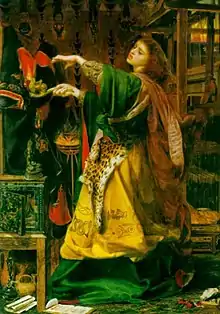 Morgan le Fay by Frederick Sandys, 1864 "Here she stands in front of a loom on which she has woven an enchanted robe, designed to consume the body of King Arthur by fire. Her appearance with her loose hair, abandoned gestures and draped leopard skin suggests a dangerous and bestial female sexuality. The green robe that Morgan is depicted wearing is actually a kimono."[1] | |
| First appearance | Vita Merlini by Geoffrey of Monmouth |
| Based on | Possibly Modron, the Morrígan, Circe, Medea, Niamh, others |
| In-universe information | |
| Species | Witch, fairy or goddess (depending on the source) |
| Gender | Female |
| Occupation | Enchantress, queen |
| Spouse | King Urien |
| Significant other | Various, including Accolon, Guiomar, Lancelot, Merlin, Ogier the Dane, Sebile |
| Children | Yvain, sometimes others |
| Relatives | Her sisters (Vita Merlini), later King Arthur's family
|
| Home | Avalon, Camelot, Gorre, Brocéliande |
Her character may have been rooted in Welsh mythology as well as other earlier myths and historical figures. The earliest account, by Geoffrey of Monmouth in Vita Merlini, refers to Morgan in conjunction with the Isle of Apples (Avalon), which is where Arthur was carried after being fatally wounded in the Battle of Camlann. There, and in the early chivalric romances by Chrétien de Troyes and others, her chief role is that of a great healer. It is Chrétien who establishes her as Arthur's supernatural elder sister.
In the Robert de Boron-derived French prose versions and the works based on them, including among them Thomas Malory's influential Le Morte d'Arthur, she is usually described as the youngest daughter of Arthur's mother, Igraine, and her first husband, Gorlois. Arthur, son of Igraine and Uther, is Morgan's half-brother; the Queen of Orkney is one of Morgan's sisters and Mordred's mother. Morgan unhappily marries Urien with whom she has a son, Yvain. She becomes an apprentice of Merlin, and a capricious and vindictive adversary of some knights of the Round Table, all the while harbouring a special hatred for Arthur's wife Guinevere. In this tradition, she is also sexually active and even predatory, taking numerous lovers that may include Merlin and Accolon, with an unrequited love for Lancelot. In some variants, including the popular retelling by Malory, Morgan is the greatest enemy of Arthur, scheming to usurp his throne, indirectly becoming an instrument of his death; however, she eventually reconciles with Arthur, retaining her original role of taking him on his final journey to Avalon.
Many other medieval and Renaissance works feature continuations of her evolutionary tale from the aftermath of Camlann as she becomes the immortal queen of Avalon in both Arthurian and non-Arthurian stories, sometimes alongside Arthur. After a period of being largely absent from modern culture, Morgan's character again rose to prominence in the 20th and 21st centuries, appearing in a wide variety of roles and portrayals.
Etymology and origins
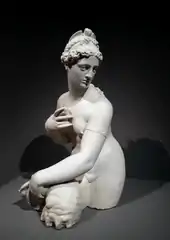
The earliest spelling of the name (found in Geoffrey of Monmouth's Vita Merlini, written c. 1150) is Morgen, which is likely derived from Old Welsh or Old Breton Morgen, meaning "Sea-born" (from Common Brittonic *Mori-genā, the masculine form of which, *Mori-genos, survived in Middle Welsh as Moryen or Morien; a cognate form in Old Irish is Muirgen, the name of a Celtic Christian shapeshifting female saint who was associated with the sea). The name is not to be confused with the unrelated Modern Welsh masculine name Morgan (spelled Morcant in the Old Welsh period).[3][4] As her epithet "le Fay" (invented in the 15th century by Thomas Malory[5] from the earlier French la fée, "the fairy"; Malory would also use the form "le Fey" alternatively with "le Fay"[6]) and some traits indicate, the figure of Morgan appears to have been a remnant of supernatural females from Celtic mythology, and her main name could be connected to the myths of Morgens (also known as Mari-Morgans or just Morgans),[7] the Welsh and Breton fairy water spirits related to the legend of Princess Dahut (Ahes). While many later works make Morgan specifically human, she retains her magical powers,[8] and sometimes also her otherworldly if not divine attributes.[7] In fact she is often referred to as either a Fairy Queen or outright a goddess (dea, déesse, gotinne) by authors.[9]
Geoffrey's description of Morgen and her sisters in the Vita Merlini closely resembles the story of the nine Gaulish priestesses of the isle of Sena (now Île de Sein) called Gallisenae (or Gallizenae), as described by the geographer Pomponius Mela during the first century, strongly suggesting that Pomponius' Description of the World (De situ orbis) was one of Geoffrey's prime sources.[10][11][12][13] Further inspiration for her character likely came from Welsh folklore and medieval Irish literature and hagiography. Speculatively, beginning with Lucy Allen Paton in 1904,[14] Morgan has been connected with the Irish shapeshifting and multifaced goddess of strife known as the Morrígan ("Great Queen").[15] Proponents of this have included Roger Sherman Loomis, who doubted the Muirgen connection.[16][17] Possible influence by elements of the classical Greek mythology sorceresses or goddesses such as Circe and especially Medea,[14][18] and other magical women from the Irish mythology such as the mother of hero Fráech,[19] as well as historical figure of Empress Matilda,[18] have been also suggested. A chiefly Greek construction is a relatively new origin theory by Carolyne Larrington.[6] One of the proposed candidates for the historical Arthur, Artuir mac Áedán, was recorded as having a sister named Maithgen (daughter of king Áedán mac Gabráin, a 6th-century king of Dál Riata), whose name also appears as that of a prophetic druid in the Irish legend of Saint Brigid of Kildare.

Morgan has also been often linked with the supernatural mother Modron,[7][20] derived from the continental mother goddess figure of Dea Matrona and featured in medieval Welsh literature. Modron appears in Welsh Triad 70 ("Three Blessed Womb-Burdens of the Island of Britain") – in which her children by Urien are named Owain mab Urien (son) and Morfydd (daughter)[21] – and a later folktale have recorded more fully in the manuscript Peniarth 147.[22] A fictionalised version of the historical king Urien is usually Morgan le Fay's husband in the variations of Arthurian legend informed by continental romances, wherein their son is named Yvain. Furthermore, the historical Urien had a treacherous ally named Morcant Bulc who plotted to assassinate him, similar to how Morgan attempts to kill Urien.[23] Additionally, Modron is called "daughter of Afallach",[24] a Welsh ancestor figure also known as Avallach or Avalloc, whose name can also be interpreted as a noun meaning "a place of apples";[25] in the tale of Owain and Morfydd's conception in Peniarth 147, Modron is called the "daughter of the King of Annwn", a Celtic Otherworld.[26] This evokes Avalon, the marvelous "Isle of Apples" with which Morgan has been associated since her earliest appearances, and the Irish legend of the otherworldly woman Niamh including the motif of apple in connection to Avalon-like Otherworld isle of Tír na nÓg ("Land of Youth").[27]
According to Gerald of Wales in De instructione principis, a noblewoman and close relative of King Arthur named Morganis carried the dead Arthur to her island of Avalon (identified by him as Glastonbury), where he was buried.[28] Writing in the early 13th century in Speculum ecclesiae, Gerald also claimed that "as a result, the fanciful Britons and their bards invented the legend that some kind of a fantastic goddess (dea quaedam phantastica)[29][30] had removed Arthur's body to the Isle of Avalon, so that she might cure his wounds there," for the purpose of enabling the possibility of King Arthur's messianic return.[31] In his encyclopaedic work Otia Imperialia, written around the same time and with similar derision for this belief, Gervase of Tilbury calls that mythical enchantress Morganda Fatata (Morganda the Fairy).[30] Morgan retains this role as Arthur's otherworldly healer in much of later tradition.
Medieval and Renaissance literature
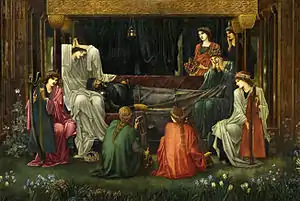
.png.webp)
Geoffrey, Chrétien and other early authors
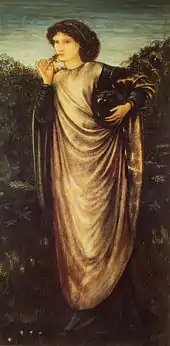
Morgan first appears by name in Vita Merlini, written by Norman-Welsh cleric Geoffrey of Monmouth. Purportedly an account of the life of Merlin, it elaborates some episodes from Geoffrey's more famous earlier work, Historia Regum Britanniae (1136). In Historia, Geoffrey relates how King Arthur, gravely wounded by Mordred at the Battle of Camlann, is taken off to the blessed Isle of Apple Trees (Latin Insula Pomorum), Avalon, to be healed; Avalon (Ynys Afallach in the Welsh versions of Historia) is also mentioned as the place where Arthur's sword Excalibur was forged. (Geoffrey's Arthur does have a sister, whose name here is Anna, but the possibility of her being a predecessor to Morgan is unknown.[5]) In Vita Merlini, Geoffrey describes this island in more detail and names Morgen as the chief of the nine magical queen sisters who dwell there, ruling in their own right. Morgen agrees to take Arthur, delivered to her by Taliesin to have him revived, but says it might take a long time. She and her sisters are capable of shapeshifting and flying ("like Daedalus, on strange wings"[9]),[32] and (at least seemingly[18]) use their powers only for good.[33] Morgen is also said to be a learned mathematician[34] and to have taught astronomy[35] to her fellow nymph (nymphae)[29] sisters, whose names are Moronoe, Mazoe, Gliten, Glitonea, Gliton, Tyronoe, Thiten and Thiton.[36] In creating this Virgin Mary-type[5] character and her sisters, Geoffrey might have been influenced by the first-century Roman cartographer Pomponius Mela, who has described an oracle at the Île de Sein off the coast of Brittany and its nine virgin priestesses believed by the continental Celtic Gauls to have the power to cure disease and perform various other awesome magic, such as controlling the sea through incantations, foretelling the future, and changing themselves into any animal.[7][37]
According to a theory postulated by R. S. Loomis, Geoffrey was not the original inventor of Morgan's character, which had already existed in hypothetical unrecorded stories of her as Arthur's fairy saviour, or even also his fairy godmother (her earliest shared supernatural ability being able to traverse on or under water). Such stories being told by wandering storytellers (as credited by Gerald of Wales) would then influence various authors writing independently from each other, especially since Vita Merlini was a relatively little-known text.[29] Geoffrey's description of Morgen is notably very similar to that of Medea in Benoît de Sainte-Maure's epic poem Roman de Troie (c. 1155–1160), a story of the ancient Trojan War in which Morgan herself makes an unexplained appearance in this second known text featuring her.[17] As Orvan the Fairy (Orva la fée, likely a corruption of a spelling such as *Morgua[lower-alpha 1] in the original-text),[38] there she first lustfully[39] loves the Trojan hero Hector and gifts him a wonderful horse, but then pursues him with hate after he rejects her. The abrupt way in which she is used suggests Benoît did expect his aristocratic audience to have been already familiar with her character.[14][18] Another ancient-times appearance can be found in the much later Perceforest (1330s), within the fourth book which is set in Britain during Julius Caesar's invasions, where the fairy Morgane lives in the isle of Zeeland and has learned her magic from Zephir. Here, she has a daughter named Morganette and an adoptive son named Passelion, who in turn have a son named Morgan, described as an ancestor of the Lady of the Lake.[40]
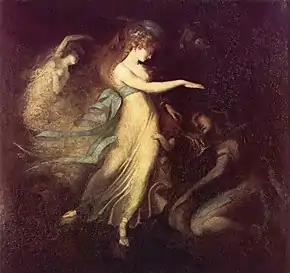
In Jaufre, an early Occitan language Arthurian romance dated c. 1180, Morgan seems to appear, without being named other than introducing herself as the "Fairy of Gibel" (fada de Gibel, the mount Gibel being a version of the Avalon motif as in later works), as the ruler of an underground kingdom who takes the protagonist knight Jaufre (Griflet) through a fountain to gift him her magic ring of protection.[29] In the romance poem Lanzelet, written by the end of the 12th century by Ulrich von Zatzikhoven, the infant Lancelot is spirited away by a water fairy (merfeine in Old High German) and raised in her paradise island country of Meidelant ("Land of Maidens"). Ulrich's unnamed fairy queen character might be also related to Geoffrey's Morgen,[19] as well as to the early Breton oral tradition of Morgan's figure, especially as her son there is named Mabuz, similar to the name of Modron's son Mabon ap Modron. In Layamon's Middle English poem The Chronicle of Britain (c. 1215), Arthur was taken to Avalon by two women to be healed there by its most beautiful elfen (aluen) queen named Argante or Argane;[14][41] it is possible her name had been originally Margan(te) before it was changed in manuscript transmission.[42]
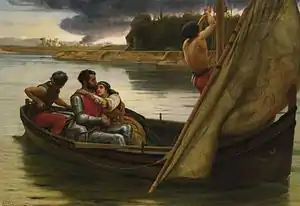
The 12th-century French poet Chrétien de Troyes already mentions her in his first romance, Erec and Enide, completed around 1170. In it, a love of Morgan (Morgue) is Guigomar (Guingomar, Guinguemar), the Lord of the Isle of Avalon and a nephew of King Arthur, a character derivative of Guigemar from the Breton lai Guigemar.[19] Guingamor's own lai by Marie de France links him to the beautiful magical entity known only as the "fairy mistress",[43] who was later identified by Thomas Chestre's Sir Launfal as Dame Tryamour, the daughter of the King of the Celtic Otherworld who shares many characteristics with Chrétien's Morgan.[44][45] It was noted that even Chrétien' earliest mention of Morgan already shows an enmity between her and Queen Guinevere, and although Morgan is represented only in a benign role by Chrétien, she resides in a mysterious place known as the Vale Perilous (which some later authors would say she has created as a place of punishment for unfaithful knights).[37][46] She is later mentioned in the same poem when Arthur provides the wounded hero Erec with a healing balm made by his sister Morgan. This episode affirms her early role as a healer, in addition to being one of the first instances of Morgan presented as Arthur's sister; healing is Morgan's chief ability, but Chrétien also hints at her potential to harm.[47]
Chrétien again refers to Morgan as a great healer in his later romance Yvain, the Knight of the Lion, in an episode in which the Lady of Norison restores the maddened hero Yvain to his senses with a magical potion provided by Morgan the Wise (Morgue la sage).[9][18] Morgan the Wise is female in Chrétien's original, as well as in the Norse version Ivens saga, but male in the English Ywain and Gawain. While the fairy Modron is mother of Owain mab Urien in the Welsh myth, and Morgan would be assigned this role in the later literature, this first continental association between Yvain (the romances' version of Owain) and Morgan does not imply they are son and mother. The earliest mention of Morgan as Yvain's mother is found in Tyolet, an early 13th-century Breton lai.[41]
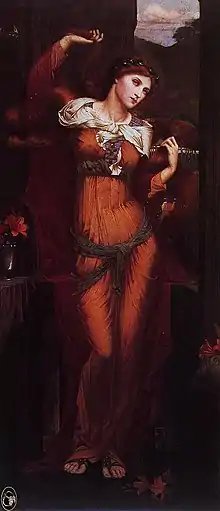
The Middle Welsh Arthurian tale Geraint son of Erbin, either based on Chrétien's Erec and Enide or derived from a common source, mentions King Arthur's chief physician named Morgan Tud. It is believed that this character, though considered a male in Gereint, may be derived from Morgan le Fay, though this has been a matter of debate among Arthurian scholars since the 19th century (the epithet Tud may be a Welsh or Breton cognate or borrowing of Old Irish tuath, "north, left", "sinister, wicked", also "fairy (fay), elf").[48][49] There, Morgan is called to treat Edern ap Nudd, Knight of the Sparrowhawk, following the latter's defeat at the hands of his adversary Geraint, and is later called on by Arthur to treat Geraint himself. In the German version of Erec, the 12th-century knight and poet Hartmann von Aue has Erec healed by Guinevere with a special plaster that was given to Arthur by the king's sister, the goddess (gotinne)[29] Feimurgân (Fâmurgân, Fairy Murgan[50]):
In writing that, Hartmann might have not been influenced by Chrétien, but rather by an earlier oral tradition from the stories of Breton bards.[29] Hartmann also separated Arthur's sister (that is Feimurgân) from the fairy mistress of the lord of Avalon (Chrétien's Guigomar), who in his version is named Marguel.[52] In the anonymous First Continuation of Chrétien's Perceval, the Story of the Grail, the fairy lover of its variant of Guigomar (here as Guingamuer) is named Brangepart, and the two have a son Brangemuer who became the king of an otherworldly isle "where no mortal lived".[53][54] In the 13th-century romance Parzival, another German knight-poet Wolfram von Eschenbach inverted Hartmann's Fâmurgân's name to create that of Arthur's fairy ancestor named Terdelaschoye de Feimurgân, the wife of Mazadân, where the part "Terdelaschoye" comes from Terre de la Joie, or Land of Joy; the text also mentions the mountain of Fâmorgân.[29][41]
Speculatively, Loomis and John Matthews further identified other perceived avatars of Morgan as the "Besieged Lady" archetype in various early works associated with the Castle of Maidens motif, often appearing as (usually unnamed) wife of King Lot and mother of Gawain. These characters include the Queen of Meidenlant in Diu Crône, the lady of Castellum Puellarum in De Ortu Waluuanii, and the nameless heroine of the Breton lai Doon, among others, including some in later works (such as with Lady Lufamore of Maydenlande in Sir Perceval of Galles).[55] Loomis also linked her to the eponymous seductress evil queen from The Queen of Scotland, a 19th-century ballad "containing Arthurian material dating back to the year 1200."[56]
A recently discovered moralistic manuscript written in Anglo-Norman French is the only known instance of medieval Arthurian literature presented as being composed by Morgan herself. This late 12th-century text is purportedly addressed to her court official and tells of the story of a knight called Piers the Fierce; it is likely that the author's motive was to draw a satirical moral from the downfall of the English knight Piers Gaveston, 1st Earl of Cornwall. Morgayne is titled in it as "empress of the wilderness, queen of the damsels, lady of the isles, and governor of the waves of the great sea."[57] She is also mentioned in the Draco Normannicus, a 12th-century (c. 1167–1169) Latin chronicle by Étienne de Rouen, which contains a fictional letter from King Arthur to Henry II of England, written for political propaganda purposes, in which 'Arthur' criticises Henry for invading Brittany and claims that he has been healed of his wounds and made immortal in Avalon by his fay sister Morgan, called an "immortal nymph" (nympha perennis).[57] Notably, it is one of the first known texts that made Morgan a sister to Arthur, as she is in the works of Chrétien and many others after him.[58]
French prose cycles
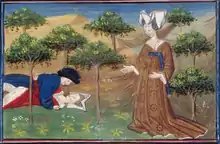
Morgan's role was greatly expanded by the unknown authors (possibly members of the Cistercian religious order, which might explain their demonisation of pagan motifs and fear of sexuality[7]) of the early-13th-century Old French romances of the Vulgate Cycle (also known as the Lancelot-Grail cycle) and especially its subsequent rewrite, the Prose Tristan-influenced Post-Vulgate Cycle. Integrating her fully into the Arthurian world, they also make Morgan's ways and deeds much more sinister and aggressive than she was presented by Geoffrey or Chrétien, as she undergoes a series of transformations and becomes a chaotic counter-heroine.[14][59] Beginning as an erratic ally of Arthur and a notorious temptress opposed to his wife and some of his knights (especially Lancelot) in the original stories of the Vulgate Cycle, Morgan's figure eventually often turns into an ambitious and depraved nemesis of King Arthur himself in the Post-Vulgate. Her common image is now a malicious and cruel sorceress, the source of many intrigues at the royal court of Arthur and elsewhere. In some of the later works, she is also subversively working to take over Arthur's throne through her mostly harmful magic and scheming, including manipulating men.[35][60] Most of the time, Morgan's magic arts correspond with these of Merlin's and the Lady of the Lake's, featuring shapeshifting, illusion, and sleeping spells (Richard Kieckhefer connected it with Norse magic[6]).[61] Although she is usually depicted in medieval romances as beautiful and seductive,[62] the medieval archetype of the loathly lady is used frequently, as Morgan can be in a contradictory fashion described as both beautiful and ugly even within the same narration.[9]
This version of Morgan (usually named Morgane or Morgain) first appears in the few surviving verses of the Old French poem Merlin, which later served as the original source for the Vulgate Cycle and consequently also the Post-Vulgate Cycle. It was written c. 1200 by the French knight-poet Robert de Boron, who described her as an illegitimate daughter of Lady Igraine with an initially unnamed Duke of Tintagel, after whose death she is adopted by King Neutres of Garlot.[14][63] Merlin is the first known work linking Morgan to Igraine and mentioning her learning sorcery after having been sent away for an education. The reader is told that Morgan was given her moniker 'la fée' (the fairy) due to her great knowledge.[64] A 14th-century massive prequel to the Arthurian legend, Perceforest, also implies that Arthur's sister was later named after its fée character Morgane from several centuries earlier.
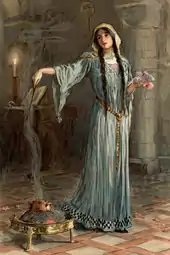
"She was known to have studied magic while she was being brought up in the nunnery."[65]
In a popular tradition from later evolution of this narrative, Morgan is the youngest of the daughters of Igraine and Gorlois, the Duke of Cornwall. In the poem's prose version and its continuations, she has at least two elder sisters (various manuscripts list up to five daughters and some do not mention Morgan being a bastard child[14]): Elaine of Garlot and the Queen of Orkney sometimes known as Morgause, the latter of whom is the mother of Arthur's knights Gawain, Agravain, Gaheris and Gareth by King Lot, and the traitor Mordred by Arthur (in some romances the wife of King Lot is called Morcades, a name that R. S. Loomis argued was another name of Morgan[66]). At a young age, Morgan is sent to a convent after Arthur's father Uther Pendragon, aided by the half-demon Merlin, kills Gorlois and rapes and marries her mother, who later gives him a son, Arthur (which makes him Morgan's younger half-brother). There, Morgan masters the seven arts and begins her study of magic, going on to specialise in astronomie (astronomy and astrology) and healing;[57][67] the Prose Merlin describes her as "wonderfully adept" and "working hard all the time."[57] The Vulgate Suite du Merlin narration describes Morgan's unmatched beauty and her various skills and qualities of character:
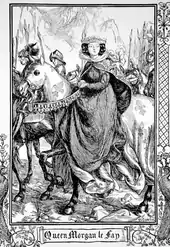
"There was a time when great was her enmity towards King Arthur, so that she plotted his ruin not once only nor twice; and that is a strange thing, for it is said that she herself was the kinswoman of the King."[68]
Uther (or Arthur himself in the Post-Vulgate[14]) betroths her to his ally, King Urien of Gor(r)e (described as an Otherworldly northern British kingdom, possibly the historical Rheged). Now a queen but unhappy with her husband, Morgan serves as a lady-in-waiting for the high queen, Arthur's newly married young wife Guinevere. At first, Morgan and the also young Guinevere are close friends, even wearing shared near-identical rings. However, everything changes when Morgan is caught in an affair with her lover Guiomar (derived from Chrétien's Guigomar) by Guinevere, who intervenes to break their relationship to prevent the loss of honour (and possibly because of Guinevere's perception of Morgan, with her kinship and close relationship with Arthur, as a rival in political power[69]). This incident, introduced in the Prose Merlin and expanded in the Vulgate Lancelot[70] and the Post-Vulgate Suite du Merlin (the Huth Merlin),[14] begins a lifelong feud between Guinevere and Morgan, who leaves the court of Camelot with all her wealth to seek out Merlin and greater powers. The pregnant Morgan later gives a birth to Guiomar's son, who is not named in the story but is said to grow up to become a great knight.[71] Morgan then either undertakes or continues her studies of dark magic under Merlin, enamored for her, the details of which vary widely depending on the telling.[39] In the Prose Merlin, for instance, it is Morgan who finds Merlin, whom she "loves passionately".[14] In the Livre d'Artus, where Morgan's first lover is named Bertolais,[72] it is rather Merlin who goes to live with Morgan and her two ladies for a long time following the betrayal of him by Niniane (the Lady of the Lake) with her other lover, just as Morgan wished for him to do.[14][39] In the Post-Vulgate Suite, Morgan had been tutored by Merlin even before her relationship with Guiomar, and later she returns to learn more.[14] They first meet at Lot's funeral; after he teaches her so much she becomes "the wisest woman in the world", Morgan scorns and drives Merlin away by threatening to torture and kill him if he would not leave her alone, which causes him great sorrow out of his "foolish love" (fol amor) for her.[14][30] In the Vulgate Lancelot, Morgan learns all her magic only from Merlin (and not in the nunnery). She then takes an unnamed knight as her new companion, until she discovers his affair with another woman, which leads to the creation of her magical domain known as the Val sans Retour (the Vale of No Return), serving as an enchanted prison for false lovers.[14] In any case, having finished her studies under Merlin, Morgan begins scheming her vengeance as she tries to undermine virtue and achieve Guinevere's downfall whenever she can.
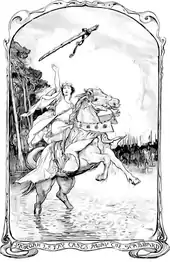
In the Post-Vulgate, where Morgan's explicitly evil nature is stated and accented, she also works to destroy Arthur's rule and end his life, but the reasons for her initial hatred of him are never fully explained other than just an extreme antipathy towards the perfect goodness which he symbolises.[14] The most famous and important of these machinations is introduced in the Post-Vulgate Suite, where she arranges for her devoted lover Accolon to obtain the enchanted sword Excalibur as well as its protective scabbard, which has been previously confided to Morgan by Arthur himself as he had trusted her even more than his wife, replacing the real ones with fakes. In a conspiracy with the villainous lord Damas, Morgan plans for Accolon to use Arthur's own magic items against him in single combat, so she and her beloved Accolon would become the rulers. As part of her convoluted plan, both Arthur and Accolon are spirited away from their hunt with Urien by a magical boat of twelve damsels. Confident of her coming victory, Morgan also attempts to murder her sleeping husband Urien with his own sword, but in this act she is stopped by their son Yvain (Uwayne), who pardons her when she protests she has been under the devil's power and promises to abandon her wicked ways.[71] After Arthur nevertheless mortally defeats Accolon in a duel arranged by Morgan, her former mentor Merlin, still having feelings for her, saves her from Arthur's wrath by enabling her to escape.[73] To avenge Accolon's death, which caused her great sorrow, Morgan again steals the scabbard from the sleeping king. Pursued by Arthur for her betrayal, Morgan throws the scabbard into a lake, before temporarily turning herself and her entourage to stone, the sight of which makes Arthur think they have been already punished by God. That action of Morgan ultimately causes the death of Arthur, who would otherwise be protected by the scabbard's magic in his final battle. On her way out, Morgan saves Arthur's knight named Manassen (Manessen, Manasses) from certain death and enables him to kill his captor when she learns Accolon was Manessen's cousin. Now banished from Camelot, Morgan retires to her lands in Gore and then to her castle near the stronghold of Tauroc (possibly in North Wales). However, her treacherous attempts to bring about Arthur's demise in the Suite are repeatedly frustrated by the king's new sorceress advisor Ninianne (the Lady of the Lake). Such is the case when Morgan sends Arthur a supposed offering of peace in the form of a rich mantle cloak; Morgan's messenger maiden is made put on the cursed gift and it burns her to cinders. It is possible that this motif was inspired by classical stories like that how Medea killed her rival for Jason's affection[74] or how Deianira sent a poisoned tunic to Hercules.[75] In one of her castles, Tugan in Garlot, Morgan has hidden a magic book given to her by Merlin, which actually prophesied the deaths of Arthur and Gawain and who would kill them, but no one can read this passage without dying instantly.[41][73]
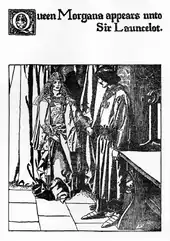
"She was clad in all the glory at her command, and her appearance was so shining and radiant that when she came into that room Sir Launcelot knew not whether it was a vision his eyes beheld or whether she was a creature of flesh and blood."[76]
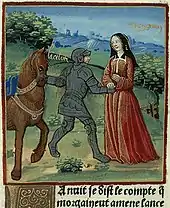
Morgan also uses her skills in dealing with various of Arthur's Knights of the Round Table, especially the greatest of them all, Lancelot, whom she alternately tries to seduce and to expose as Guinevere's adulterous lover. Her magic aside, Lancelot is always disempowered in his dealings with Morgan as he could never hurt a woman or fight a kin of his king, which allows the writers to make her a perfect foil for Lancelot as "the woman he most feared in the world."[14][77] Morgan is emphasised as promiscuous, even more than her sister Morgause, as she is "so lustful and wanton that a looser [noble]woman could not have been found."[78] Her many paramours include Huneson the Bald (Hemison, Onesun), who is mortally wounded when he attacks Tristan out of his jealously for Morgan's attention; he soon dies after returning to her, and the anguished Morgan buries him in a grand tomb. In one variation, she then takes possession of the lance that was used to kill Huneson, enchants it, and sends it to King Mark of Cornwall, her possible lover,[79] who years later uses it to slay Tristan.[41] In the Prose Tristan, wherein Morgan presents herself as Arthur's full sister,[14] she delivers by Lamorak to Arthur's court a magical drinking horn from which no unfaithful lady can drink without spilling, hoping to disgrace Guinevere by revealing her infidelity, but it is Iseult whose adultery is disclosed instead. Lancelot is Morgan's prime object of sexual desire but he consistently refuses her obsessive advances due to his great love of Guinevere, even as Morgan repeatedly courts, drugs, enchants or imprisons the knight. Their one-sided relationship (as well as interactions between her and Arthur[14]) may evoke that of the goddess Morrígan and the Celtic hero Cú Chulainn.[80] One of such occasions has Lancelot captured in Cart Castle (Charyot) by Morgan and two other lascivious enchantresses, Queen Sebile (Sedile) and the unnamed Queen of Sorestan, each of whom wants to make him her lover, but he refuses to choose and escapes with the help of one of their maidservants, Rocedon.[41] The three enchantresses "knew so much about magic, they enjoyed one another's company and always rode together and ate and drank together." Sebile and Morgan are particularly close companions, working their magic together, but they tend to fall into petty squabbles due to their rivalries and bad tempers, including a conflict between them when they both seduce Lancelot's brother Hector de Maris in the late 13th-century Prophéties de Merlin. Their friendship is further tested when a quarrel over a handsome widower named Berengier (captured by Sebile after Morgan kidnapped his child) ends in a violent attack by Sebile that leaves Morgan half-dead; Morgan swears revenge, but their relationship is later restored.[63] After Merlin's entombment by the Lady of the Lake, Morgan and her three enchantresses also try to find and rescue him but they fail in that task.[30] Morgan's other allies in the Prophéties include the opponents of chivalry such as Mark and Claudas, and she enlists the help of the latter in her failed attempt to eliminate the Lady of the Lake.[81] In one of her schemes, she even sends Lucifer himself (in the guise of a dragon) against Segurant the Brown (Segurant le Brun).[29][82]
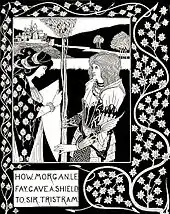
Besides Lancelot, Morgan's fancied good knights include Tristan, but her interest in him turns into burning hatred of him and his true love Isolde after he kills her lover as introduced in the Prose Tristan (Morgan does not become their enemy in the Italian versions). Another is the rescued-but-abducted young Alexander the Orphan (Alisaunder le Orphelin), a cousin of Tristan and Mark's enemy from a later addition in the Prose Tristan as well as the Prophéties de Merlin, whom she promises to heal but he vows to castrate himself rather than to pleasure her. Nevertheless, Alexander promises to defend her castle of Fair Guard (Belle Garde), where he has been held, for a year and a day, and then dutifully continues to guard it even after the castle gets burned down;[41][83] this eventually leads to his death.[34] In the Val sans Retour, Lancelot frees the 250 unfaithful knights entrapped by Morgan, including Morgan's own son Yvain and her former lover Guiomar whom she has turned to stone for his infidelity.[41] (Of note, Guiomar, appearing there as Gaimar, is also Guinevere's early lover instead of her cousin in the German version Lancelot und Ginevra.) Morgan then captures Lancelot himself under her spell using a magic ring and keeps him prisoner in the hope Guinevere would then go mad or die of sorrow. She also otherwise torments Guinevere, causing her great distress and making her miserable until the Lady of the Lake gives her a ring that protects her from Morgan's power.[84] On one occasion, she lets the captive Lancelot go to rescue Gawain when he promises to come back (but also keeping him the company of "the most beautiful of her maidens" to do "whatever she could to entice him"), and he keeps his word and does return; she eventually releases him altogether after over a year, when his health falters and he is near death.[85] It is said that Morgan concentrates on witchcraft to such degree that she goes to live in seclusion in the exile of far-away forests. She learns more spells than any other woman, gains an ability to transform herself into any animal, and people begin to call her Morgan the Goddess (Morgain-la-déesse, Morgue la dieuesse).[29][30][81] In the Post-Vulgate version of Queste del Saint Graal, Lancelot has a vision of Hell where Morgan still will be able to control demons even in afterlife as they torture Guinevere.[86] Later, after she hosts her nephews Gawain, Mordred and Gaheriet to heal them, Mordred spots the images of Lancelot's passionate love for Guinevere that Lancelot painted on her castle's walls while he was imprisoned there; Morgan shows them to Gawain and his brothers, encouraging them to take action in the name of loyalty to their king, but they do not do this.[87] With same intent, when Tristan was to be Morgan's champion at a jousting tournament, she also gives him an enchanted shield depicting Arthur, Guinevere and Lancelot to deliver to Camelot (in the Prose Tristan).[84]
.png.webp)
In the Vulgate La Mort le Roi Artu (The Death of King Arthur, also known as just the Mort Artu), Morgan ceases troubling Arthur and vanishes for a long time, and Arthur assumes her to be dead. But one day, he wanders into Morgan's remote castle while on a hunting trip, and they meet and instantly reconcile with each other. Morgan welcomes him warmly and the king, overjoyed with their reunion, allows her to return to Camelot, but she refuses and declares her plan to move to the Isle of Avalon, "where the women live who know all the world's magic," to live there with other sorceresses. However, disaster strikes when the sight of Lancelot's frescoes and Morgan's confession finally convinces Arthur about the truth to the rumours of the two's secret love affair (about which he has been already warned by his nephew Agravain). This leads to a great conflict between Arthur and Lancelot, which brings down the fellowship of the Round Table. The goddess Fortune, who appears to Arthur to foretell his death towards the end the Vulgate Cycle, is regarded by some as a double for Morgan.[88] In the Mort Artu, Morgan is among the black-hooded ladies who take the dying Arthur to his final rest and possible revival in Avalon. Depending on the manuscript, she is either the leading lady (usually, being recognised by Girflet as the one holding Arthur's hand as he enters the boat), a subordinate to another who is unnamed, or neither of them are superior.[89] The latter part of the Post-Vulgate versions of Queste and Mort both revert to Morgan's friendly and helpful attitude toward Arthur from the Vulgate Cycle, even as she makes no mention of Avalon or her intentions when taking him away. Arthur steps into her boat after Camlann but assures he is not going to return. His supposed grave is later said to be found mysteriously empty but for his helmet.[14] (The Spanish poem La Faula has Morgan explain that by saying the tomb's purpose was to prevent a search for Arthur.)
Malory and other medieval English authors
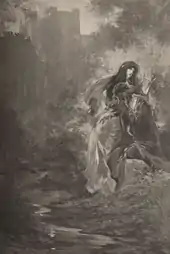
"With haughty, wicked eyes and lovely face, Studied him steadily a little space."[90]
Middle English writer Thomas Malory follows the portrayals of Morgan from the Old French prose cycles in his late-15th-century seminal work of the selective compilation book Le Morte d'Arthur (The Death of Arthur), though he reduces her in role and detail of characterisation, in particular either removing or limiting her traditions of healing and prophecy, and making her more consistently and inherently evil just as he makes Merlin more good.[14] He also diminishes Morgan's conflict with Guinevere, as there is no motif of Guiomar and Accolon is her first named lover (appearing as Accolon of Gaul in a much abbreviated version of his story[6]), but does not clarify Morgan's motivations for her antagonistic behaviour against Arthur.[58][78] Malory scholar Elizabeth Sklar described Morgan's character here as "an essentially sociopathic personality, respecting no boundaries and acknowledging no rules save those dictated by her own ambitions, envy, and lust."[91] Up until the war between Arthur and Lancelot and the rebellion of Mordred, it is Morgan who remains the main and constant source of direct and indirect threat to the realm.[58] According to Corinne Saunders, Malory's "Morgan is also characterized as following the pattern of the otherworldly ruler who wishes both to destroy and to possess bodies" of knights through sex and manipulation.[6] As noted by Mary Lynn Saul: "Curiously, in spite of all her powers, Morgan is rarely successful in any of her plots. Nevertheless, she remains a medieval symbol of the potential danger of uncontrolled female power."[92] Some modern researchers attribute Malory's "personal misogyny" to his portrayal of Morgan as well as women in general.[93]
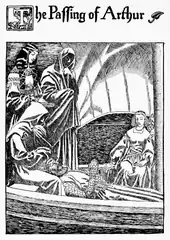
"And Sir Bedivere stood upon the shore and looked upon the face of King Arthur as it lay within the lap of Queen Morgana, and he beheld that the face of King Arthur was white like to the ashes of wood, wherefore he wist that he was dead."[94]
In Malory's backstory, Morgan has studied astrology as well as nigremancie (which might actually mean black magic in general rather than "necromancy"[95]) in the nunnery where she was raised, before being married to Urien (Uriens) as a young teenager; in this narrative she did not study with Merlin.[58] Unlike Malory's Nimue, Morgan deals mostly in "black" rather than "white" magic, employed usually through enchantments and potions.[6] Her powers, however, seem to be inspired by fairy magic of Celtic folklore rather than by medieval Christian demonology.[34] Malory mentions Arthur's attempts to conquer at least one of her castles, which originally had been his own gift to her, and which he could not retake (apparently due to magical defences[92]). She also plots an elaborate ambush in "The Book of Sir Tristram de Lyons", after learning of the death of one of her favourites in a tournament, but Tristan ends up killing or routing thirty of her knights when the ambush ends in a disaster. Morgan is widely feared and hated, so much that "many knights wished her burnt." She is now the leader of the four (not three) witch queens who capture Lancelot (the others being the Queen of the Northgales, the Queen of Eastland, and the Queen of the Outer Isles). In an episode that had been first introduced by the anonymous writer of the earlier Prose Lancelot, Lancelot rescues Elaine of Corbenic from being trapped in an enchanted boiling bath by Morgan and the Queen of the Northgales, both envious of Elaine's great beauty (echoing Circe's treatment of Scylla[14]). However, despite all of their prior hostility towards each other and her numerous designs directed against Arthur personally (and his own promise to get a terrible revenge on her as long as he lives[58]), Malory's Morgan is still redeemed and is one of the four grieving enchantress queens (the others being Nimue, marking the end of conflict between her and Morgan,[96] and two of Morgan's allies, the Queen of the Northgales and the Queen of the Wasteland) who arrive in a black boat to transport the wounded king to Avalon in the end. Unlike in the French and earlier stories on which Le Morte d'Arthur is based, and where Morgan and Arthur would either have first made peace or have just never fought to begin with, here her change of attitude towards him is sudden and unexplained.[5][58][97] Arthur is last seen in Morgan's lap, with her lament of sorrow referring to him as her "dear brother" (dere brothir), as they disappear from the work's narrative together. And, also as in the Vulgate Mort Artu (and the English poem Alliterative Morte Arthure[98]), Morgan also appears as Lady Fortune with the Wheel of Fortune to warn Arthur prior to his fatal final battle.
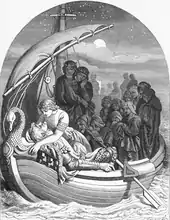
Morgan also appears in some other English texts, such as the early-13th-century Anglo-Norman Roman de Waldef where she is only "name-dropped" as a minor character.[99] Middle English romance Arthour and Merlin, written around 1270, casts a villainous Morgan in the role of the Lady of the Lake and gives her a brother named Morganor as an illegitimate son of King Urien; her wondrous castle Palaus is built mostly of crystal and glass.[41] Conversely, a 14th-century Middle English version of the Vulgate Mort Artu known as the Stanzaic Morte Arthur makes Morgan an unquestionably good sister of Arthur, concerned only about his honour in regard to the affair of Lancelot and Guinevere. Entering her boat (she is not named in the scene, but addresses him as her brother), Arthur believes he is going to be healed, yet his tomb is later discovered by Bedivere.[14]
At the end of the 14th-century Middle English romance Sir Gawain and the Green Knight, one of the best-known Arthurian tales, it is revealed that the entire Green Knight plot has been instigated by Gawain's aunt, the goddess[100] Morgan le Fay (Morgue la Faye, Morgne þe goddes[30]), whose prior mentorship by Merlin is mentioned.[101] Here, she is an ambiguous trickster[34] who takes an appearance of an elderly woman (contrasting from the beautiful Lady Bertilak in a role evoking the loathly lady tradition[102]), as a test for Arthur and his knights and to frighten Guinevere to death. Morgan's importance to this particular narrative has been disputed and called a deus ex machina[103] and simply an artistic device to further connect Gawain's episode to the Arthurian legend, but some regard her as a central character and the driving force of the plot.[9][69] Opinions are also divided regarding Morgan's intentions and whether she succeeds or fails,[104] and how the story's shapeshifting and enigmatic Morgan might be, or might be not, also Lady Bertilak herself.[97]
Other later appearances
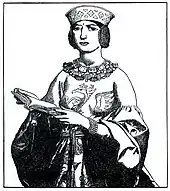
Morgan further turns up throughout the Western European literature of the High and Late Middle Ages in a variety of roles, generally in works related to the cycles of Arthur (the Matter of Britain) or Charlemagne (the Matter of France). They often feature Morgan as a lover and benefactor (and sometimes opponent, especially when being turned down) of various heroes, sometimes also introducing her additional offspring or alternate siblings, or connecting her closer with the figure of the Lady of the Lake. For instance, the Old French anonymous Li Romans de Claris et Laris better known as just Claris and Laris (c. 1270),[105] has its Morgane la Faye (Morgana in the modern English translation) as a fully supernatural being, a former sister of Arthur as well as a former pupil of the Lady of Lake, Viviane (Viviana). Still ever lascivious and sexual, Morgan now lives in a splendid enchanted castle in the wilderness (identified as Brocéliande in a later manuscript) with twelve other beautiful fairy ladies including the sorceress Madoine (Madoina). There, they lure and ensnare many hundreds of young and attractive knights, who then spend the rest of their lives in the palace.[29][106][107] Morgan is named Dioneta in the 14th-century Welsh text known as The Birth of Arthur, where she is a sister of both Gwyar (Morgause) and Gwalchmei (Gawain), as well as of the other sisters Gracia and Graeria, and is sent off by Uther to Avallach (Avalon).[108] In Thomas III of Saluzzo's Le Chevalier Errant, la fée Morgane holds the eponymous Wandering Knight captive inside a magnificent castle in her forest land Païenie ("Pagania"), but after her brother Arthur sends messengers she agrees to lift her enchantment and let him go.[109] The fairy queen Lady Morgan (Dame Morgue, Morgue li fee) shows up in Adam de la Halle's late-13th-century French story Jeu de la feuillée, in which she visits a contemporary Arras.[110] Spanish public edicts dating from the end of the 14th and the beginning of the 15th century tell of the belief in Morgane continuing to enchant and imprison people at Tintagel and in "the Valley of False Trickery".[111]
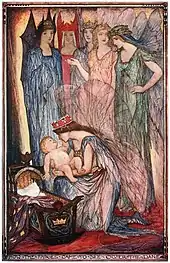
"And, in tones more musical than mortals often hear, she sang a sweet lullaby, a song of fairyland and of the island of Avalon, where the souls of heroes dwell."[112]
In the legends of Charlemagne, she is associated with the Danish legendary hero Ogier the Dane: following his initial epics, when he is 100 years old, the fairy queen Morgan restores him to his youthful form but removes his memory, then takes him to her mystical island palace in Avalon (where Arthur and Gawain are also still alive) to be her lover for 200 years. She later protects him during his adventures in the mortal world as he defends France from Muslim invasion, before his eventual return to Avalon.[113] In some accounts, Ogier begets her two sons, including Marlyn (Meurvin);[41][114] in the 14th-century Ly Myreur des Histors by the French-Belgian author Jean d'Outremeuse, one of their sons is a giant[29] and they live in a palace made of jewels.[57] In the 13th-century chanson de geste of Huon of Bordeaux, she is a protector of the eponymous hero and the mother of the fairy king Oberon by none other than Julius Caesar.[115] In Ogier le Danois, Morgan (Morgue la Fée) lives in her palace in Avalon together with Arthur and Oberon, who both seem to be her brothers.[41][116] In another chanson de geste, the early-13th-century La Bataille Loquifer, the fays[29] Morgan and her sister Marsion (Marrion) bring the Saracen hero Renoart to Avalon, where Arthur is the king, and Renoart's union with Morgan gives him an illegitimate son named Corbon (Corbans).[41] When Renoart jilts her and escapes, Morgan sends her demonic monster servant Kapalu (derived from the Welsh legends' Cath Palug[117]) after him; the shipwrecked Renoart ends up luckily rescued by a mermaid.
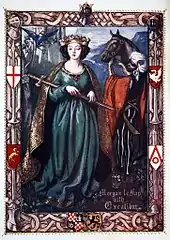
The island of Avalon is often described as an otherworldly place ruled by Morgan in other later texts from all over Western Europe, especially these written in Iberia. In the 14th-century French Crusadic fantasy Le Bâtard de Bouillon, the island kingdom of Arthur and his fairy sister Morgan the Beautiful is hidden by a cloud in the Red Sea,[118] where it is visited by King Bauduins (Baldwin II of Jerusalem). In his 14th-century Catalan poem La faula, Guillem de Torroella claims to have himself having visited the Enchanted Isle and met Arthur who has been brought back to life by the fay Morgan (Morgan la feya, Morguan la fea)[29] and they both are now forever young due to the power of the Holy Grail.[119] In the 15th-century Valencian romance Tirant lo Blanc, the noble Queen Morgan searches the world for her missing brother; finally finding him entranced in Constantinople, Morgan brings Arthur back to his senses by removing Excalibur from his hands, after which they leave to Avalon.[120][121] The Castilian Arderique begins where the Mort Artu ends, that is with the departure and disappearance of Arthur and his sister Morgaina, described there as a fairy and a necromancer, after the battle with Mordred (Mordered).[122] Francisco de Enciso Zárate's Florambel de Lucea (1532) features a later appearance of Arthur together with his sister Morgaina, "better known as Morgana the fairy" (fada Morgana), who explains how she saved her brother and gifts Excalibur (Escaliber) to the eponymous hero Florambel.[123][124] In Tristán de Leonis, Morgana offers her love to Tristan.[125] In the story La fada Morgana, the protagonist Joana ends up marrying the fairy queen Morgana's son named Beuteusell after passing his mother's test with his help.[126][127]
The 14th-century Italian romance titled La Pulzella Gaia (The Merry Maiden)[128] features the titular beautiful young daughter of Morgana (Italian version of Morgan's name, here too also a sister of the Lady of the Lake) with Hemison. In her own tale, Morgana's daughter defeats Gawain (Galvano) in her giant serpent form before becoming his lover; she and her fairy army then save Gawain from the jealous Guinevere, who wants Gawain dead after having been spurned by him. She then herself is imprisoned in a magical torment in her mother's glass-and-diamond magical castle Pela-Orso, because of how Morgana wanted to force her to marry Tristan. Eventually, Gawain storms the castle after three years of siege and frees her from a cursed dungeon, also capturing her tyrannical mother for the same punishment.[129][130] The 15th-century Italian manuscript La Tavola Ritonda (The Round Table) too makes Morgan a sister to the Lady of the Lake as well as to Arthur. It is based on the French prose romances, but here Morgan is a prophetic figure whose main role is to ensure the fulfilment of fate.[79] Her daughter also appears, as Gaia Donzella, in the Tavola Ritonda, where she is kidnapped by the knight Burletta of the Desert (Burletta della Diserta) who wants to rape her but she is rescued by Lancelot. The Italian Morgana appears in a number of cantari poems of the 14th to 15th century. Some of these are original new episodes, such as the Cantari di Tristano group's Cantare di Astore e Morgana, in which Morgana heals Hector de Maris (Astore) and gives an armour made in Hell as well as a magical ship, and the Cantari del Falso Scudo that features her fairy son, the Knight with the Enchanted Shield; the Ponzela Gaia is another telling of the familiar story of Morgana's fairy daughter.[131][132][133][134] Evangelista Fossa combined and retold some of them in his Innamoramento di Galvano (Gawain Falling in Love, c. 1494).[135]
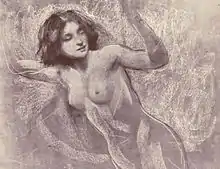
Morgan le Fay, or Fata Morgana in Italian, has been in particular associated with Sicily as a location of her enchanted realm in the mythological landscape of medieval Europe (at least since the Norman conquest of southern Italy),[136] and local folklore describes her as living in a magical castle located at or floating over Mount Etna.[41] As such she gave her name to the form of mirage common off the shores of Sicily, the Fata Morgana, since the 14th century.[136][137] References linking Avalon to Sicily can be found in Otia Imperialia (c. 1211) and La faula, as well as in Breton and Provençal literature, for example in the aforementioned Jaufre and La Bataille Loquifer. The 13th-century Chrétien-inspired romance Floriant et Florete places Morgan's secret mountain castle of Mongibel (Montgibel or Montegibel, derived from the Arabic name for Etna), where, in the role of a fairy godmother, Morgan (Morgane) and two other fays[29] spirit away and raises Floriant, a son of a murdered Sicilian king and the hero of the story. Floriant, with the help of her magic ship, eventually reunites with Morgan at her castle when he returns there with his wife Florete.[41] The 15th-century French romance La Chevalier du Papegau (The Knight of the Parrot) gives Morgaine the Fairy of Montgibel (Morgaine, la fée de Montgibel, as she is also known in Floriant et Florete)[138] a sister known as the Lady Without Pride (la Dame sans Orgueil), whom Arthur saves from the evil Knight of the Wasteland (similar to the story in the Tavola Ritonda). Meanwhile, the Fastnachtspiel (Ain Hupsches Vasnacht Spill von Künig Artus), a German retelling of the enchanted horn episode, moved Morgan's Mediterranean Sea island domain to the east of Sicily, referring to her only as the Queen of Cyprus.[139]

During the Italian Renaissance, Morgan has been primarily featured in relation to the cycle of epic poems of Orlando (based on Roland of the historical Charlemagne). In Matteo Maria Boiardo's late-15th-century Orlando Innamorato, fata Morgana (initially as lady Fortune[140]) is beautiful but wicked fairy enchantress, a sister of King Arthur and a pupil of Merlin. Morgana lives in her paradise-like garden in a crystal cavern under a lake, plotting to eventually destroy the entire world. There, she abducts her favourites until she is thwarted by Orlando who defeats, chases and captures Morgana, destroying her underwater prison and letting her keep only one of her forced lovers, a knight named Ziliante.[141] In Ludovico Ariosto's continuation of this tale, Orlando Furioso (1532), Morgana (also identified as Morgan Le Fay) is revealed as a twin sister of two other sorceresses, the good Logistilla and the evil Alcina; the latter appears after Orlando again defeats Morgana, rescuing Ziliante who has been turned into a dragon, and forces Morgana to swear by her lord Demogorgon to abandon her plots. It also features the medieval motif where uses a magic horn to convince Arthur of the infidelity of his queen (Geneura), here successfully. Bernardo Tasso's L'Amadigi (1560) further introduces Morgana's three daughters: Carvilia, Morganetta, and Nivetta, themselves temptresses of knights.[142]
Morgan's other 16th-century appearances include these of Morgue la fée in François Rabelais' French satirical fantasy novel Les grandes chroniques du grand et énorme géant Gargantua et il publie Pantagruel (1532)[143] and of the good Morgana in Erasmo di Valvasone's Italian didactic poem La caccia (1591).[144] In Edmund Spenser's English epic poem The Faerie Queene (1590), Argante (Layamon's name for Morgan) is lustful giantess queen of the "secret Ile", evoking the Post-Vulgate story of Morgan's kidnapping of Sir Alexander. It also features three other counterpart characters: Acrasia, Duessa, and Malecasta, all representing different themes from Malory's description of Morgan.[145] Morgan might have also inspired the characters of the healer Loosepaine and the fay Oriande in the Scots poem Greysteil[146] (possibly originally written in 15th-century England).
Modern culture
The character Morgan le Fay has become ubiquitous in Arthurian works of the modern era, spanning fantasy, historical fiction and other genres across various mediums, especially since the mid-20th century.[147] A dedicated article deals with the subject in detail, including listing many of her modern appearances.
See also
![]() Media related to Morgan le Fay at Wikimedia Commons
Media related to Morgan le Fay at Wikimedia Commons
Notes
- Variant spellings of the name in the manuscripts include: orua, orna, oua, ornains, orueins, oruain, ornais, morgain, moruein, moran, and moranz.[38]
References
Citations
- "Morgan-le-Fay". Birmingham Museums & Art Gallery Pre-Raphaelite Online Resource: The Collection. Retrieved 11 June 2018.
- "Definition of FATA MORGANA". www.merriam-webster.com. Retrieved 12 May 2019.
- Lot, Ferdinand, "Morgue la Fée et Morgan-Tud", in: Romania 28 (1899), pp. 321–28.
- Koch, John, Celtic Culture, ABC-CLIO, 2006, p. 16; 458; 537; 702; 1602.
- Dalecky, Elke (2008). Different Faces of Morgan le Fay: The Changing Image of the Sorceress in Arthurian Literature (PDF). University of Vienna.
- Mangle, Josh (2018). "Echoes of Legend: Magic as the Bridge Between a Pagan Past and a Christian Future in Sir Thomas Malory's Le Morte Darthur". Graduate Theses.
- Carver, Dax Donald (2006). Goddess Dethroned: The Evolution of Morgan le Fay. Department of Religious Studies, Georgia State University, Atlanta.
- Briggs, Katharine (1978). "Morgan le Fay". In Encyclopedia of Fairies: Hobgoblins, Brownies, Boogies, and Other Supernatural Creatures, p. 303. New York: Pantheon. ISBN 0-394-73467-X.
- McGill, Anna (2015). Magic and Femininity as Power in Medieval Literature. East Tennessee State University, Johnson City.
- Curley, Michael J., Geoffrey of Monmouth, Cengage Gale, 1994, p. 119.
- Koch, John, Celtic Culture, ABC-CLIO, 2006, p. 146.
- Hofeneder, Andreas, Die Religion der Kelten in den antiken literarischen Zeugnissen: Von Cicero bis Florus, Austrian Academy of Sciences Press, 2008, p. 273.
- Faral, Edmond, La légende arthurienne, études et documents: Des origines à Geoffroy de Monmouth, H. Champion, 1929, pp. 303–307.
- Enstone, Zoë Eve (2011). 'Wichecraft & Vilaine': Morgan le Fay in Medieval Arthurian Literature (PDF). University of Leicester.
- Fries, Maureen (1994). "From The Lady to The Tramp: The Decline of Morgan le Fay in Medieval Romance" (PDF). Arthuriana. 4: 1–18. doi:10.1353/art.1994.0018. S2CID 162377628. Retrieved 19 September 2015.
- Loomis, Roger Sherman (1958). "Objections to the Celtic origin of the "Matière de Bretagne"". Romania (in French). 79 (313): 47–77. doi:10.3406/roma.1958.3112. ISSN 0035-8029.
- Loomis, Roger S. (1945). "Morgain La Fee and the Celtic Goddesses". Speculum. 20 (2): 183–203. doi:10.2307/2854594. JSTOR 2854594. S2CID 161308783.
- Shearer, John Christopher (2017). Masks of the Dark Goddess in Arthurian Literature: Origin and Evolution of Morgan le Fay. Eastern Kentucky University, Richmond.
- Pérez, The Myth of Morgan la Fey, p. 95.
- Charlotte Spivack, Roberta Lynne Staples. "Morgan le Fay: Goddess or Witch?". The Company of Camelot: Arthurian Characters in Romance and Fantasy (Greenwood Press, 2000), pp. 32–45.
- Bromwich, Trioedd Ynys Prydein, p. 195.
- Preserved in Peniarth 147. See Bromwich, Trioedd Ynys Prydein, pp. 449–451.
- Guest, Charlotte (1877). The Mabinogion: From the Llyfr Coch O Hergest (the Red Book of Hergest) with an English Translation and Notes.
- Koch, John T.; Minard, Antone (2012). The Celts: A-H. ABC-CLIO. ISBN 9781598849646.
- Bromwich, Trioedd Ynys Prydein, pp. 274–275.
- Harward, Vernon J. (1958). The Dwarfs of Arthurian Romance and Celtic Tradition. E. J. Brill, Leiden.
- Newcomb, Jacky; Geddes-Ward, Alicen (29 November 2007). A Faerie Treasury. Hay House, Inc. p. 93. ISBN 978-1-8485-06930.
- Faedo, Avalon Revisited, p. 134.
- Loomis, Roger Sherman (1959). "Morgain la fée in oral tradition". Romania. 80 (319): 337–367. doi:10.3406/roma.1959.3184. ISSN 0035-8029.
- Larrington, Carolyne. "The Enchantress, the Knight and the Cleric: Authorial Surrogates in Arthurian Romance'". Retrieved 7 September 2015 – via Academia.edu.
- "Two Accounts of the Exhumation of Arthur's Body: Gerald of Wales". Encyclopædia Britannica. Archived from the original on 3 October 2013. Retrieved 1 January 2015.
- Hebert, Shapeshifter, p. 43.
- Larrington, King Arthur's Enchantresses, p. 8.
- Oliver, Cheyenne (2015). Which Witch?: Morgan le Fay as Shape-Shifter and English Perceptions of Magic Reflected in Arthurian Legend (PDF). Florida Atlantic University, Boca Raton.
- Capps, Sandra Elaine (1996). Morgan le Fay as Other in English Medieval and Modern Texts. University of Tennessee, Knoxville.
- Algernon Herbert (1836). Britannia After the Romans, p. 11, ISBN 1104627353.
- "The Camelot Project: Morgan le Fay". D.lib.rochester.edu. Retrieved 1 January 2015.
- Schöning, Udo, Thebenroman - Eneasroman - Trojaroman: Studien zur Rezeption der Antike in der französischen Literatur des 12. Jahrhunderts, Walter de Gruyter, 1991, p. 209.
- Goodrich, Peter H. (2004). Merlin: A Casebook. Routledge. pp. 149–150. ISBN 9781135583408.
- Perceforest: The Prehistory of King Arthur's Britain. DS Brewer. 2011. ISBN 9781843842620.
- Bruce, Christopher W. (1999). The Arthurian Name Dictionary. Taylor & Francis. ISBN 978-0-8153-2865-0. Retrieved 24 May 2010.
- Faedo, Avalon Revisited, p. 135.
- Pérez, The Myth of Morgan la Fey, pp. 73–75.
- Hebert, Shapeshifter, p. 47.
- Figg, Kristen; Crane, Susan. "Animal Encounters: Contacts and Concepts in Medieval Britain". Academia.edu. Retrieved 7 September 2015.
- Larrington, King Arthur's Enchantresses, p. 40.
- Hebert, Shapeshifter, p. 44.
- Paton, Lucy Allen. Studies in the Fairy Mythology of Arthurian Romance, Ginn, 1903, pp. 259–274.
- Loomis, Roger Sherman. Arthurian Tradition and Chretien de Troyes, Columbia University Press, 1949, p. 488.
- Aue, Hartmann Von (1982). Erec. U of Nebraska Press. ISBN 978-0803273290.
- Larrington, King Arthur's Enchantresses, p. 11.
- Vivian, Kim (1 November 2010). Arthurian Romances, Tales, and Lyric Poetry: The Complete Works of Hartmann Von Aue. Penn State Press. ISBN 9780271043593.
- Paton, Lucy Allen (1903). Studies in the Fairy Mythology of Arthurian Romance. Ginn.
- Loomis, Roger Sherman (1 August 2005). Celtic Myth and Arthurian Romance. Chicago Review Press. ISBN 9781613732106.
- Matthews, John (25 March 2003). Sir Gawain: Knight of the Goddess. Inner Traditions / Bear & Co. ISBN 9780892819706 – via Google Books.
- Loomis, Roger Sherman; Roberts, Ruth (18 August 1970). "Studies in Medieval Literature: A Memorial Collection of Essays". B. Franklin – via Google Books.
- Twomey, Michael. "'Morgan le Fay, Empress of the Wilderness': A Newly Recovered Arthurian Text in London, BL Royal 12.C.ix". Retrieved 7 September 2015 – via Academia.edu.
- Zafra, Laura Calvo (2015). The Female Figure as the Antagonist in the Arthurian World: The Role of Morgan le Fay in Thomas Malory's Morte Darthur (PDF). Autonomous University of Barcelona.
- Marxen, Lis. "The Role of Women in the Arthurian Material". Retrieved 7 September 2015 – via Academia.edu.
- Markale, Jean (1 June 1995). Merlin: Priest of Nature. Simon and Schuster. ISBN 9781620554500 – via Google Books.
- Orlická, Barbora (2012). Magic in the Arthurian Legends (PDF). Department of English and American Studies, Masaryk University, Brno.
- Saunders, Corinne J. (2010). Magic and the Supernatural in Medieval English Romance. Boydell & Brewer. ISBN 9781843842217.
- Larrington, King Arthur's Enchantresses, p. 41.
- Sommer, H. Oskar (Heinrich Oskar). "The Vulgate Version of the Arthurian Romances (Volume 1)". Carnegie Institution of Washington – via Internet Archive.
- Knowles, James; Malory, Thomas (1895). The Legends of King Arthur and His Knights. New York: Warne and Co.
- R. S. Loomis, Scotland and the Arthurian Legend. Retrieved 26 January 2010.
- Larrington, King Arthur's Enchantresses, p. 15.
- Clay, Beatrice (1913). Stories from King Arthur and His Round Table. New York Public Library. London : J. M. Dent & Sons Limited; New York : E. P. Dutton & Company.
- Pomerleau, Lainie (2013). When Family and Politics Mix: Female Agency, Mixed Spaces, and Coercive Kinship in Sir Gawain and the Green Knight, The Awntyrs off Arthure at Terne Wathelyne, and "The Deth of Arthur" from Le Morte Darthur. University of Tennessee, Knoxville.
- "The Tournament at Logres; King Lot and his Sons; and Morgan and Gyomar". d.lib.rochester.edu. Robbins Library Digital Projects.
- Hebert, Shapeshifter, p. 71.
- Sommer, H. Oskar (Heinrich Oskar). "The Vulgate Version of the Arthurian Romances (Volume 1)". Carnegie Institution of Washington – via Internet Archive.
- Larrington, King Arthur's Enchantresses, p. 33.
- Larrington, King Arthur's Enchantresses, p. 36.
- Hebert, Shapeshifter, p. 170.
- Pyle, Howard (1905). The Story of the Champions of the Round Table. New York Public Library. New York: Scribner.
- Hopkins, Amanda; Rouse, Robert Allen; Rushton, Cory James (2014). Sexual Culture in the Literature of Medieval Britain. Boydell & Brewer Ltd. ISBN 9781843843795.
- Scott, Cynthia A (2014). Creating Her Own Power: Morte Darthur's Morgan le Fay. University of Texas–Pan American, Edinburg.
- Larrington, King Arthur's Enchantresses, p. 83.
- Martins, Ana Rita (2015). Morgan le Fay: The Inheritance of the Goddess (PDF). Universidade de Lisboa, Faculdade de Letras (ULICES).
- Larrington, King Arthur's Enchantresses, p. 13.
- Larrington, King Arthur's Enchantresses, p. 87.
- Larrington, King Arthur's Enchantresses, p. 88.
- Larrington, King Arthur's Enchantresses, pp. 42–43.
- Hebert, Shapeshifter, p. 69.
- Larrington, King Arthur's Enchantresses, p. 24.
- Larrington, King Arthur's Enchantresses, p. 45.
- Pérez, The Myth of Morgan la Fey, p. 3.
- Sommer, H. Oskar (Heinrich Oskar). "The Vulgate Version of the Arthurian Romances (Volume 6)". Carnegie Institution of Washington – via Internet Archive.
- "Accolon of Gaul | Robbins Library Digital Projects". d.lib.rochester.edu. Retrieved 1 February 2019.
- Puškášová, Pavla (2013). Femininity and Death in Arthurian Legends. Department of English Language and Literature, Masaryk University, Brno.
- Saul, MaryLynn (2010). Malory's Morgan le Fay: The Danger of Unrestrained Feminine Power. Worcester State College.
- Leitch, Megan G; Rushton, Cory James, eds. (2019). A New Companion to Malory. Boydell & Brewer. doi:10.2307/j.ctv136bvg0. ISBN 9781787444447. JSTOR j.ctv136bvg0.
- Pyle, Howard (1910). The Story of the Grail and the Passing of King Arthur. New York Public Library. New York: Charles Scribner's Sons.
- Larrington, King Arthur's Enchantresses, p. 16.
- Keys, Amanda Leigh (2009). Characterizing Action: Sir Thomas Malory's Development of Character in Le Morte Darthur (PDF). Baylor University, Waco.
- Kopřivová, Monika (2007). Women Characters in Arthurian Literature (PDF). Department of English and American Studies, Faculty of Arts, Masaryk University, Brno.
- Barber, Chris; Pykitt, David (15 January 1997). Journey to Avalon: The Final Discovery of King Arthur. ISBN 9781578630240.
- Field, P. J. C. (18 August 2004). Arthurian Studies in Honour of P.J.C. Field. DS Brewer. ISBN 9781843840138 – via Google Books.
- Still, Angie. "An Exploration of the Evolution of the Arthurian Myth". Academia.edu. Retrieved 7 September 2015.
- North, Richard. "Morgan le Fay and the fairy mound in 'Sir Gawain and the Green Knight'". Academia.edu. Retrieved 7 September 2015.
- Clare, Patricia (2001). "Sovereign Fantasies: Arthurian Romance and the Making of Britain". Questia. Retrieved 19 September 2015.
- Albert B. Friedman, "Morgan le Fay in Sir Gawain and the Green Knight" in Speculum, volume 35, pp. 260–274.
- Neimneh, Shadi; Al-Thebyan, Qusai (2012). "The Obstacle and the Way: Women and Gender in Sir Gawain and the Green Knight". Cite journal requires
|journal=(help) - "Claris and Laris". Robbins Library Digital Projects. Retrieved 3 June 2018.
- Pérez, The Myth of Morgan la Fey, p. 108.
- Wade, J. (23 May 2011). Fairies in Medieval Romance. Springer. ISBN 9780230119154.
- Barber, Chris; Pykitt, David (1997). Journey to Avalon: The Final Discovery of King Arthur. Weiser Books. ISBN 9781609251468.
- Thomas III; Chaubet, Daniel (2001). Le chevalier errant (in French). Centro interuniversitario di ricerche sul viaggio in Italia.
- Jeu de la feuillée (PDF) (in French).
- Hook, The Arthur of the Iberians, p. 148.
- "Gateway to the Classics: The Story of Roland by James Baldwin". gatewaytotheclassics.com. Retrieved 1 February 2019.
- Silverberg, Robert. "The Realm of Prester John by Robert Silverberg, 1972 | Online Research Library". Questia. Retrieved 19 September 2015.
- Larrington, King Arthur's Enchantresses, p. 94.
- Sion, C.M.H. (translated). Saints and She-Devils (Foundation Werkplaats Wetenschap, NL). Rubicon Press, 1987. ISBN 0-948695-06-4.
- Keightley, Thomas (1828). The Fairy Mythology. ISBN 9781365619786.
- Apollinaire, Guillaume (1972). L'enchanteur pourrissant: Éd. établie, présenté et annotée par Jean Burgos (in French). Lettres modernes.
- Lacy, Norris J.; Ashe, Geoffrey; Ihle, Sandra Ness; Kalinke, Marianne E.; Thompson, Raymond H. (5 September 2013). The New Arthurian Encyclopedia: New edition. Routledge. ISBN 9781136606335.
- Torroella, Guillem de. Compagna, Anna Maria (ed.). "La faula". rialc.unina.it (in Catalan). Retrieved 3 July 2018.
- Hook, The Arthur of the Iberians, p. 155.
- Martorell, Joanot (4 September 2013). Tirant Lo Blanc. Knopf Doubleday Publishing Group. ISBN 9780307828545.
- Cervantes, Biblioteca Virtual Miguel de (21 October 2001). "Arderique : (1517) [selección]" – via www.cervantesvirtual.com. Cite journal requires
|journal=(help) - Hook, The Arthur of the Iberians, p. 184.
- Perdomo, María del Rosario Aguilar (2004). Florambel de Lucea: primera parte, libros I, II y III : Valladolid, Nicola Tierri, 1532 : guía de lectura (in Spanish). Centro Estudios Cervantinos. ISBN 9788488333971.
- Hook, The Arthur of the Iberians, p. 289.
- "Bramimonda i els cavallers carolingis (778)". dBalears (in Catalan). 1 February 2004. Retrieved 9 March 2019.
- "El tractament de la dona com a pensadora en l Aplec de rondaies mallorquines d Antoni M. Alcover". docplayer.es (in Spanish). Retrieved 9 March 2019.
- Rajna, Pio (ed.). Pulzella Gaia: Cantare Cavalleresco (in Italian) (1893 ed.).
- Varanini, Giorgio (1959). "Il manoscritto quattrocentesco della " Ponzela Gaia "". Scriptorium (in Italian). 13 (1): 70–79. doi:10.3406/scrip.1959.3001. ISSN 0036-9772.
- Busby, Keith; Thompson, Raymond H. (8 November 2005). Gawain: A Casebook. Routledge. ISBN 9781136783517.
- "Cantari arturiani". Maria Bendinelli Predelli. 11 July 2016. Retrieved 14 January 2019.
- Lacy, Norris J.; Ashe, Geoffrey; Ihle, Sandra Ness; Kalinke, Marianne E.; Thompson, Raymond H. (2013). The New Arthurian Encyclopedia: New edition. Routledge. ISBN 9781136606335.
- Tether, Leah; McFadyen, Johnny (2017). Handbook of Arthurian Romance: King Arthur's Court in Medieval European Literature. Walter de Gruyter GmbH & Co KG. ISBN 9783110432466.
- The Arthur of the Italians: The Arthurian Legend in Medieval Italian Literature and Culture. University of Wales Press. 15 April 2014. ISBN 9781783160518.
- "FOSSA, Evangelista in "Dizionario Biografico"". treccani.it (in Italian). Retrieved 14 January 2019.
- Adeleye, Gabriel; Acquah-Dadzie, Kofi; Sienkewicz, Thomas J.; McDonough, James T. (1999). World Dictionary of Foreign Expressions: a Resource for Readers and Writers. Bolchazy-Carducci Publishers. p. 142. ISBN 978-0-86516-423-9.
- Green, Thomas (2009). Arthuriana: Early Arthurian Tradition and the Origins of the Legend (PDF). The Lindes Press.
- Larrington, King Arthur's Enchantresses, p. 93.
- https://www.era.lib.ed.ac.uk/bitstream/1842/7363/1/384205.pdf
- Bane, Theresa (30 August 2013). Encyclopedia of Fairies in World Folklore and Mythology. McFarland. ISBN 9781476612423.
- Cavallo, Jo Ann (1993). Boiardo's Orlando Innamorato: An Ethics of Desire. Fairleigh Dickinson University Press. p. 108. ISBN 978-0-8386-35346.
- Cavallo, Jo Ann (2004). The Romance Epics of Boiardo, Ariosto, and Tasso: From Public Duty to Private Pleasure. University of Toronto Press. ISBN 9780802089151.
- Taylor, Jane H. M. (2014). Rewriting Arthurian Romance in Renaissance France: From Manuscript to Printed Book. Boydell & Brewer Ltd. ISBN 9781843843658.
- La caccia (PDF) (in Italian).
- Hebert, Shapeshifter, pp. 110–116.
- Caldwell, James R. (1965). "A Medieval Romance of Friendship: Eger and Grime. Mabel van Duzee". Speculum. 40 (1): 170–172. doi:10.2307/2856494. JSTOR 2856494.
- "Thoroughly Modern Morgan: Morgan le Fey in Twentieth-Century Popular Arthuriana". Sklar, Elizabeth S., in Popular Arthurian Traditions pp. 24–32. ISBN 0-87972-562-1.
Bibliography
| Wikisource has the text of the 1905 New International Encyclopedia article "Morgan, the Fay". |
- Bromwich, Rachel (1963). Trioedd Ynys Prydein: The Triads of the Island of Britain. University of Wales Press. ISBN 978-0708313862.
- Faedo, María José Alvarez, ed. (2007). Avalon Revisited: Reworkings of the Arthurian Myth. Literary Criticism. Peter Lang. ISBN 978-3039112319.
- Thebert, Jill Marie (2008). Shapeshifter: The Manifestations of Morgan le Fay. ISBN 978-0549756644.
- Hook, David (15 June 2015). The Arthur of the Iberians: The Arthurian Legends in the Spanish and Portuguese Worlds. University of Wales Press. ISBN 9781783162437.
- Larrington, Carolyne (2006). King Arthur's Enchantresses: Morgan and Her Sisters in Arthurian Tradition. I.B. Tauris. ISBN 978-1784530419.
- Pérez, Kristina (2014). The Myth of Morgan la Fey. Palgrave Macmillan. ISBN 978-1137332981.
External links
| Wikimedia Commons has media related to Morgan le Fay. |
- Morgan le Fay at The Camelot Project